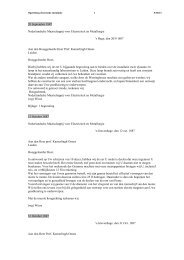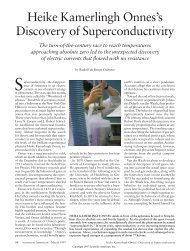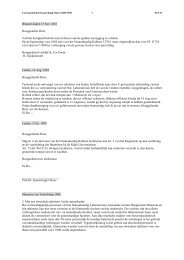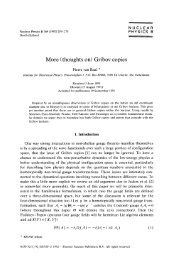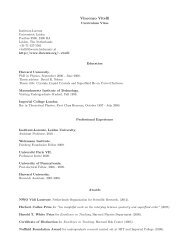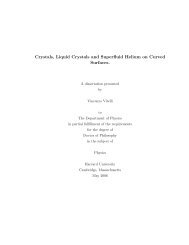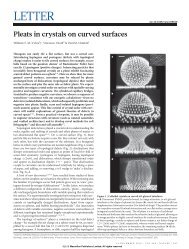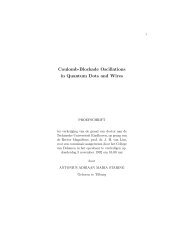You also want an ePaper? Increase the reach of your titles
YUMPU automatically turns print PDFs into web optimized ePapers that Google loves.
simplicity, the mini-domain V1/V2 epitope<br />
designed by McLellan et al. may well be a more<br />
straightforward target for re-eliciting potent<br />
neutralizing antibodies by active vaccination.<br />
However, uncertainties remain. First, does<br />
the scaffolded V1/V2 mimic reported here<br />
accurately represent the respective molecular<br />
architecture of the actual gp120 trimer? The<br />
answer would come with the structure of the<br />
trimeric envelope glycoprotein, although the<br />
reduced affinity of PG9 for the scaffolded<br />
mimic 3 compared with that estimated for the<br />
trimeric glycoproteins suggests differences.<br />
Second, it is not clear how common this<br />
type of interaction between antibodies and<br />
glycopeptide antigens is. But there is reason<br />
to be optimistic. McLellan et al. propose 3 that<br />
the epitopes of two other related, but distinct,<br />
neutralizing antibodies (CH04 and PGT145)<br />
have similar structures. Moreover, another<br />
potent neutralizing antibody, PGT128, binds<br />
a remarkably similar type of glycopeptide<br />
SOFT MATeriAlS<br />
<strong>Marginal</strong> <strong>matters</strong><br />
structure in a different region of gp120 called<br />
the V3 loop 11 . This suggests that the production<br />
of glycopeptide-reactive, broadly neutralizing<br />
antibodies may not be a particularly rare event<br />
during HIV-1 infection. The convergent evolution<br />
in antibody recognition also suggests that<br />
the immune system is rising to the challenge<br />
of generating antibodies with appropriate<br />
shapes to fit the structural constraints required<br />
to pierce the gp120 glycan shield and interact<br />
with protein surfaces beneath.<br />
Vaccination relies on triggering the immune<br />
system’s B cells to produce antibodies. Will<br />
vaccination with appropriately designed<br />
antigen mimics such as that described in this<br />
paper 3 elicit equivalent antibody responses<br />
to those seen during HIV-1 infection? This<br />
cannot be answered yet. What we do know<br />
is that B cells from some individuals infected<br />
with HIV-1 recognize this type of glycopeptide<br />
epitope after stringent selection and a<br />
substantial degree of mutational evolution to<br />
Most soft materials, such as sand, can be in either a solid-like or a liquid-like<br />
state. New experiments probe the surprisingly rich nonlinear physics that can<br />
occur in between these two states. See Letter p.355<br />
VincenzO ViTelli & MArTin VAn Hecke<br />
All around us, things are falling apart.<br />
The foam on our cappuccinos looks<br />
solid, but gentle stirring irreversibly<br />
changes its shape. Sand, a granular material,<br />
mimics a solid when we walk on the beach<br />
but a liquid when we pour it out of our shoes.<br />
Such examples suggest that we can think of<br />
the mechanics of soft disordered materials<br />
as either jammed (solid-like) or unjammed<br />
(freely flowing). On page 355 of this issue,<br />
however, Bi et al. 1 describe experiments showing<br />
that such materials come in more than just<br />
these two flavours.<br />
The hybrid behaviour of sand and foams has<br />
fascinated physicists for decades, and lies at the<br />
heart of Liu and Nagel’s jamming diagram 2<br />
(see Fig. 1a of the paper 1 ). The idea behind<br />
this diagram is that the mechanical state of a<br />
whole range of soft materials — such as granular<br />
media, pastes, foams and emulsions — is<br />
controlled by how densely their constituents<br />
(grains, bubbles or droplets) are packed. Dense<br />
packings are jammed, loose packings are<br />
unjammed, and when the constituent particles<br />
just touch, the material is said to be marginal.<br />
Think of mayonnaise, an emulsion of oil droplets<br />
in water: only when a sufficient amount of<br />
oil is added to the mixture do the oil droplets<br />
start to touch and the mayonnaise acquires its<br />
solid-like consistency.<br />
Bi and colleagues’ experiments 1 suggest that<br />
the jamming diagram should be revisited to<br />
describe a broader variety of states than the<br />
strictly jammed and unjammed ones. The<br />
authors placed a granular material consisting<br />
of small plastic discs in a box whose side walls<br />
could be moved in order to compress or shear<br />
(deform without compression) the material.<br />
The discs were photoelastic and so permitted<br />
direct visualization of the forces operating<br />
a b<br />
NEWS & VIEWS RESEaRch<br />
increase antibody binding strength for antigen.<br />
Whether vaccination can select the appropriate<br />
B-cell specificities and drive sufficient antibody<br />
evolution remains to be seen, but this is<br />
likely to be the major remaining hurdle on the<br />
way to an antibody-based HIV-1 vaccine. ■<br />
Quentin J. Sattentau is in the Sir William<br />
Dunn School of Pathology, University of<br />
Oxford, Oxford OX1 3RE, UK.<br />
e-mail: quentin.sattentau@path.ox.ac.uk<br />
1. Burton, D. R. et al. Proc. Natl Acad. Sci. USA 108,<br />
11181–11186 (2011).<br />
2. Wei, X. et al. Nature 422, 307–312 (2003).<br />
3. McLellan, J. S. et al. Nature 480, 336–343 (2011).<br />
4. Walker, L. M. et al. Science 326, 285–289 (2009).<br />
5. Pejchal, R. et al. Proc. Natl Acad. Sci. USA 107,<br />
11483–11488 (2010).<br />
6. Pancera, M. et al. J. Virol. 84, 8098–8110 (2010).<br />
7. Zhou, T. et al. Nature 445, 732–737 (2007).<br />
8. Wu, X. et al. Science 329, 856–861 (2010).<br />
9. Azoitei, M. L. et al. Science 334, 373–376 (2011).<br />
10. Chen, L. et al. Science 326, 1123–1127 (2009).<br />
11. Pejchal, R. et al. Science 334, 1097–1103 (2011).<br />
between them when the material was subjected<br />
to deformation: the more incident light<br />
that went through the material, the larger the<br />
forces 3 .<br />
The first question Bi et al. addressed was,<br />
what happens when such granular material is<br />
sheared? Typically, when we spread mayonnaise<br />
on a sandwich, smear foam on our skin or<br />
kick a sandcastle, we unjam these materials. By<br />
contrast, the authors 1 find that, when sheared<br />
under constant volume, collections of loose,<br />
unjammed discs build up pressure and resist<br />
further deformation — they become rigid.<br />
This phenomenon is reminiscent of Reynolds’<br />
dilatancy, in which granular mater ials expand<br />
when sheared under constant pressure. A<br />
familiar manifestation of this is how footprints<br />
on a wet beach tend to become dry as the<br />
deformed sand expands and sucks in water.<br />
The second question Bi et al. tackled was,<br />
what is the nature of the novel states in which<br />
mechanical rigidity is generated by shearing?<br />
Figure 1 | Fragile and shear-jammed states. Bi and colleagues 1 studied a granular material consisting<br />
of small plastic discs and subjected it to shear deformation. a, For small applied shear deformation, the<br />
material becomes fragile: the discs come into contact with each other mostly in one direction (here,<br />
vertical). b, For large applied shear deformation, the material is said to be shear-jammed: the discs come<br />
into contact with each other in more than one direction. The intensity of light seen on each grain is<br />
proportional to the amount of force it experiences.<br />
15 December 2011 | VOL 480 | NATUre | 325<br />
J. ZhAng & R. BehRingeR, Duke univ.
RESEaRch<br />
NEWS & VIEWS<br />
The authors show that these states are anisotropic,<br />
as evidenced from the patterns formed<br />
by the bright, load-bearing discs. For moderate<br />
anisotropies, the states seem to be fully<br />
jammed: they are rigid enough to resist deformation<br />
in any direction. These are shearjammed<br />
states. However, in the case of strong<br />
anisotropy, the packings become fragile: the<br />
discs come into contact with each other mostly<br />
in one direction (Fig. 1). Such fragile packings 4<br />
can resist deformation in some directions but<br />
not in others. These packings are thus neither<br />
fully jammed nor fully unjammed.<br />
To account for their findings, Bi et al. suggest<br />
a modification to the jamming diagram:<br />
in addition to the areas describing the jammed<br />
and unjammed states, there should be an<br />
in-between region for the fragile and shearjammed<br />
states (see Fig. 1b of the paper 1 ). All<br />
of these states should meet near a point known<br />
as the marginal or jamming point, at which the<br />
rigidity vanishes.<br />
This proposed diagram is specifically geared<br />
towards frictional granular media. But the idea<br />
of fragile states 5 , which are extremely susceptible<br />
to perturbation and emerge from the<br />
marginal point, is more general. Many soft<br />
materials — including granular media, emulsions,<br />
foams and polymer networks — can<br />
be prepared in a state of vanishing rigidity<br />
and thus become marginal materials. Several<br />
examples are emerging 6–10 that show precisely<br />
how the mechanical response of such marginal<br />
materials becomes strongly nonlinear.<br />
The closer they come to the marginal point,<br />
the lower the driving force needed to access<br />
this fully nonlinear regime. At the marginal<br />
point, even the tiniest perturbation produces<br />
an extremely nonlinear mechanical response.<br />
One example of the nonlinear behaviour of<br />
fragile matter is the mechanics of networks of<br />
randomly arranged springs. These reach a marginal<br />
state when the average number of springs<br />
equals twice the number of network nodes.<br />
Such networks are floppy if fewer springs are<br />
present and become rigid when extra springs<br />
are added, provided that they are under relatively<br />
weak stress. In between these two regimes,<br />
there is a window of extreme response: when<br />
the spring network is near its marginal state, its<br />
response becomes completely nonlinear 6 .<br />
A second example is the flow of foams and<br />
soft colloidal suspensions. Under low stress,<br />
these exhibit a liquid-like state for low densities<br />
and a solid-like state for high densities.<br />
In between these two states, an intermediate<br />
regime of nonlinear flow arises 7,8 .<br />
A third example is waves in granular media.<br />
Under large pressure, linear elastic waves<br />
occur. However, at low pressures the material<br />
approaches its marginal point, and even a<br />
gentle touch can generate strongly nonlinear<br />
shock waves 9,10 .<br />
Bi and colleagues’ work 1 underscores the<br />
surprisingly rich nonlinear physics that<br />
governs marginal soft matter. The simplest<br />
326 | NATUre | VOL 480 | 15 December 2011<br />
manifestation of this nonlinear behaviour<br />
can be found near the marginal point.<br />
In many cases, it is unclear exactly what<br />
happens when such fragile materials are subjected<br />
to stress. But what is clear is that being<br />
marginal <strong>matters</strong>. ■<br />
Vincenzo Vitelli is at the Lorentz Institute,<br />
Faculty of Mathematics and Natural Sciences,<br />
and Martin van Hecke is in the Kamerlingh<br />
Onnes Laboratory, Faculty of Mathematics<br />
and Natural Sciences, Leiden University,<br />
2300 RA Leiden, the Netherlands.<br />
e-mails: vitelli@lorentz.leidenuniv.nl;<br />
mvhecke@physics.leidenuniv.nl<br />
SuprAMOleculAr cHeMiSTry<br />
Molecular wires<br />
get connected<br />
1. Bi, D., Zhang, J., Chakraborty, B. & Behringer, R. P.<br />
Nature 480, 355–358 (2011).<br />
2. Liu, A. J. & nagel, S. R. Nature 396, 21–22 (1998).<br />
3. Majmudar, T. S. & Behringer, R. P. Nature 435,<br />
1079–1082 (2005).<br />
4. Cates, M. e., Wittmer, J. P., Bouchaud, J.-P. &<br />
Claudin, P. Phys. Rev. Lett. 81, 1841–1844 (1998).<br />
5. de gennes, P.-g. & Badoz, J. Fragile Objects: Soft<br />
Matter, Hard Science, and the Thrill of Discovery<br />
(Springer, 1996).<br />
6. Wyart, M., Liang, h., kabla, A. & Mahadevan, L.<br />
Phys. Rev. Lett. 101, 215501 (2008).<br />
7. Olsson, P. & Teitel, S. Phys. Rev. Lett. 99, 178001<br />
(2007).<br />
8. nordstrom, k. n. et al. Phys. Rev. Lett. 105, 175701<br />
(2010).<br />
9. nesterenko, v. F. Dynamics of Heterogeneous<br />
Materials (Springer, 2011).<br />
10. gómez, L. R., Turner, A. M., van hecke, M. & vitelli, v.<br />
Preprint at http://arxiv.org/abs/1108.5688 (2011).<br />
A long-standing issue in nanotechnology is how to connect molecular electronic<br />
devices. A method for splicing nanoscale wires made from different materials<br />
paves the way towards a solution to this problem.<br />
DAriO M. BASSAni<br />
What could be easier than joining two<br />
wires together? Just about anything,<br />
if the wires in question are only<br />
14 nanometres thick. Such nano wires are the<br />
future of miniaturization for electronics, but<br />
are so small that they cannot be handled with<br />
tweezers or through other mechanical means.<br />
Another problem is that, so far, such wires have<br />
been composed of only one type of molecule,<br />
which has limited their potential as components<br />
of future electronic devices 1 . Reporting in<br />
Science, Zhang et al. 2 now describe an approach<br />
for making nanowires in which tubular sections<br />
made from different molecular building<br />
blocks are connected together. Developing<br />
methods for joining materials that have different<br />
electronic properties is an essential step<br />
towards building nanometre-scale electronic<br />
devices such as diodes and transistors.<br />
To achieve their aims, Zhang et al. built discshaped<br />
molecules fitted with long hydro carbon<br />
chains on one side and a metal-binding site on<br />
the other. When the authors allowed a solution<br />
of the molecules to mix slowly with methanol,<br />
the molecules spontaneously assembled<br />
into tubes (Fig. 1). This happens because the<br />
molecules do not dissolve well in methanol —<br />
as the concentration of the methanol in the<br />
mixture increases, the disc-shaped molecules<br />
stick together to avoid being in contact with it.<br />
As they aggregate, the molecules partly overlay<br />
one another in a way that forms tubular<br />
nanowires.<br />
Zhang et al. constructed the central disc of<br />
the molecules from carbon atoms with the<br />
same electronic configuration as graphene<br />
sheets 3 — that is, with atoms that form an aromatic,<br />
hexagonal network of alternating single<br />
and double bonds. This makes the molecules<br />
especially good at transporting charges when<br />
they are ‘doped’ (mixed with small quantities<br />
of another compound that partly ionizes<br />
the molecules) or illuminated with light. The<br />
authors also prepared similar molecules in<br />
which some of the hydrogen atoms on the<br />
periphery of the central disc were replaced by<br />
fluorine. This reduced the electron density in<br />
the disc, making the molecules better electron<br />
acceptors than the non-fluorinated analogues.<br />
Zhang et al. then used molecular wires made<br />
from the non-fluorinated molecules as ‘seeds’<br />
that promoted the deposition of the fluorinated<br />
molecules from solution as new tubular<br />
segments at the ends of the seed wires (Fig. 1).<br />
The authors designed their system so that<br />
the molecules in the different segments of the<br />
wires do not scramble after they are mixed.<br />
Such behaviour is highly unusual because it<br />
seems to undermine a fundamental premise<br />
of molecular self-assembly: electron-rich<br />
molecules prefer to mix with electron-poor<br />
ones to form alternating layers of each molecule,<br />
analogous to the way that small magnets<br />
spontaneously align with their magnetic poles<br />
opposed. To understand why no scrambling<br />
occurs, we need to consider the basics of selfassembly<br />
processes.<br />
Molecular self-assembly is driven by a



